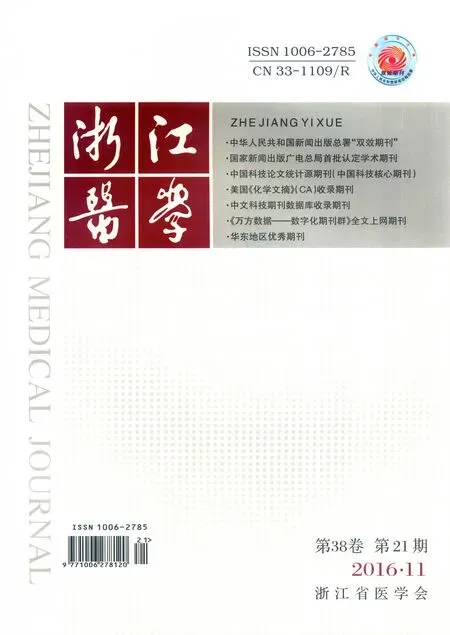肘关节恐怖三联征损伤患者术后功能结果和并发症的荟萃分析
陈红卫 王子阳 李军
●临床研究
肘关节恐怖三联征损伤患者术后功能结果和并发症的荟萃分析
陈红卫 王子阳 李军
目的 评估肘关节恐怖三联征损伤患者手术治疗后的功能结果和并发症。方法 在Medline、EMBASE、Cochrane Library和Google Scholar等数据库检索关于肘关节恐怖三联征损伤的前瞻性、回顾性研究,并分析各项研究的患者术后功能结果和并发症。结果 最终纳入16项研究,共312例患者。术后随访25~30个月,Mayo肘关节功能评分78~95分,Broberg-Morrey评分76~90分,肩臂手功能缺陷(DASH)评分9~31分。需再手术的并发症发生率范围0.0%~54.5%,总发生率为22.4%(70/312);需再手术的并发症主要与内固定问题、关节僵硬、关节不稳、尺神经麻痹等相关。无需再手术的并发症主要是异位骨化(12.5%,39/312)和关节炎(11.2%,35/312)。结论 肘关节恐怖三联征损伤术后功能结果令人满意,并发症较为常见,建议进一步规范手术技术以获得最佳功能结果,减少并发症。
并发症 功能结果 肘关节恐怖三联征损伤
肘关节脱位伴随桡骨头骨折、冠状突骨折,其治疗极具挑战性,术后并发症易导致预后不佳,故被称为肘关节恐怖三联征损伤[1]。这种类型的损伤通常由于上肢伸展位跌倒时低能量或高能量肘关节损伤,导致前臂外翻、旋后和轴向挤压所引起。本文通过检索文献就肘关节恐怖三联征损伤术后功能结果、并发症作一分析。
1 资料和方法
1.1 文献资料 以“elbow triad terrible,coronoid fracture,radial fracture,elbow fracture and elbow dislocation”等为检索词,在Medline、EMBASE、Cochrane Library和Google Scholar等数据库检索相关文献,检索时间到2013年7 月31日,语言限制为英语;共纳入16篇文献[7-22],文献选择见图1。纳入标准:文献中涉及肘关节恐怖三联征损伤(elbow dislocation,radial head fracture and coronoid process fracture),英文出版。排除肘关节恐怖三联征损伤合并其他损伤,以作者来信、评论、编辑社论或个案报道形式发表的文献。
1.2 方法 由2位评价员对文献进行独立筛选及评价,若意见不一致,先讨论决定是否纳入,若不能解决则请第三方协助裁决。从每篇选中的文献中提取以下数据和信息:作者人数及详细资料,患者年龄、随访时间、桡骨头骨折的Mason分型[23]、冠状突骨折的Regan-Morrey分型[24]、术后肘关节功能评分[Mayo肘关节功能评分[1]:90~ 100分为优,75~89分为良,60~74分为可,<60为差;Broberg-Morrey评分[25]:95~100分为优,80~94分为良,60~79分为可,<60分为差;肩臂手功能缺陷(DASH)评分[26]:评分0~100分,分数越高表示上肢功能越差]以及并发症。

图1 文献选择的示意图
2 结果
2.1 基本情况 除了Zeiders等[11]研究,其余15项研究均为回顾性研究。16项研究的患者共312例,其中87.5%(14/16)研究报道男性患者构成>50%;年龄40~49岁;随访时间13.6~64.0个月,其中25~30个月较为常见,见表1。

表1 16项研究的患者基本情况
2.2 功能结果 16项研究中有8项进行了Mayo肘关节功能评分,平均范围78~95分(2项研究评分为优,6项研究评分为良);共报道了155例患者,其中Mayo肘关节功能评分为优61例(39.4%),良66例(42.6%),可23例(14.8%),差5例(3.2%)。16项研究中有7项进行了Broberg-Morrey评分,平均范围76~90分(2项研究评分为优,5项研究评分为良);共报道了98例患者,其中Broberg-Morrey评分为优27例(27.6%),良39例(39.8%),可24例(24.5%),差8例(8.1%)。16项研究中有8项进行了DASH评分,平均范围是9~31分,见表2。
2.3 并发症 除了3项研究的患者无需再手术[11-12,19],其他13项研究的患者均需再手术,再手术率范围在0.0%~ 54.5%。312例患者中有70例因并发症需再手术,主要并发症与内固定问题、关节僵硬、关节不稳、尺神经麻痹等有关,少数与伤口感染有关。无需再手术的主要并发症是异位骨化 [占12.5%(39/312),10个研究]和关节炎[11.2%(35/312),4个研究]:Toros等[19]报道16例患者中6例(37.5%)存在Ⅰ级关节炎;Garrigues等[18]报道40例患者中5例(12.5%)存在异位骨化;Seijas等[14]报道18例患者中4例(22.2%)存在异位骨化;Lindenhovius等[21]报道18例患者中9例(50.0%)存在Ⅰ级关节炎,3例(16.7%)存在Ⅱ级关节炎;Forthman等[22]报道22例患者中6例(27.3%)存在Ⅰ级关节炎,1例(4.5%)存在Ⅱ级关节炎;Egol等[10]报道37例患者中18例(48.6%)存在异位骨化;Ring等[11]报道11例患者中10例(90.9%)存在肱尺关节炎,见表3。

表2 16项研究的患者术后功能结果

表3 16项研究的患者术后并发症发生情况

注:LCL为外侧相关韧带;MCL为内侧相关韧带;*依据Broberg-Morrey标准
3 讨论
16项纳入研究312例患者术后并发症(包括需再手术、无需再手术)较为常见,但肘关节功能结果(包括Mayo肘关节功能评分、Broberg-Morrey评分和DASH评分)总体令人满意。按照Mayo肘关节功能评分和Broberg-Murrey评分,70%以上的患者功能优良;与早期研究结果一致[6]。但仍有少数患者存在并发症,如尺神经麻痹、肘关节僵硬、异位骨化、关节炎等;其中1/3以下患者因关节不稳、僵硬等问题需再手术。Mathew等[2]在2009年发表了《肘关节恐怖三联征损伤手术治疗规范》,本文纳入的研究中有3项研究未报道无需再手术的并发症[11-12,19],然而,其中2项是小样本研究(≤16)[12,19],1项研究报道32例患者术前行CT三维重建,且使用一个标准的治疗原则,部分患者发生异位骨化但文中未提及任何并发症需再手术[11]。通常,肘关节恐怖三联征损伤术后并发症发生率较高,因此今后需进一步改进手术方法。
本文通过系统回顾解释功能结果和并发症,但存在以下限制:(1)除1项研究[15]外,其余15项研究均为回顾性研究,因此尚需更多前瞻性研究的证据;(2)本文包含了相对大数量的研究(纳入研究16项),患者312例,但仍需从更大规模的研究中提取更确切的证据,但肘关节恐怖三联征损伤相对少见,因此很难形成大规模研究;(3)本文缺乏同质性,不同研究的手术方法、治疗不同,如桡骨头骨折、冠状突骨折的类型和随访时间不同,可在一定程度上影响肘关节功能结果和并发症的发生。
综上所述,肘关节恐怖三联征损伤术后,多数患者功能结果令人满意,但仍有部分患者因术后发生并发症需再手术。目前肘关节恐怖三联征损伤的手术策略和技术基本一致,为了减少并发症,建议进一步改善手术技术、手术管理,以改善术后肘关节功能结果,减少并发症的发生。
[1] Morrey B F,Sanchez-Sotelo J.The elbow and its disorders[M]. Philadelphia:Saunders/Elsevier,2009:1211.
[2] Mathew P K,Athwal G S,King G J.Terrible triad injury of the elbow:current concepts[J].J Am Acad Orthop Surg,2009,17(3):137-151.
[3] Dodds S D,FishlerT.Terrible triad ofthe elbow[J].Orthop Clin North Am,2009,44(1):47-58.
[4] Rockwood C A,Green D P.Rockwood and Green's fractures in adults[M].Philadelphia:Lippincott-Raven,1996:581-588.
[5] Pipicelli J G,Chinchalkar S J,Grewal R,et al.Rehabilitation considerations in the management of terrible triad injury to the elbow [J].Tech Hand Up Extrem Surg,2011,15(4):198-208.
[6] Rodriguez-Martin J,Pretell-MazziniJ,Andres-Esteban E M,et al. Outcomes after terrible triads of the elbow treated with the current surgicalprotocols.Areview[J].Int Orthop,2011,35(6):851-860.
[7] Ring D,Jupiter J B,Zilberfarb J.Posterior dislocation of the elbow with fractures of the radial head and coronoid[J].J Bone Joint Surg Am,2002,84-A(4):547-551.
[8] Pugh D M,Wild L M,Schemitsch E H,et al.Standard surgical protocol to treat elbow dislocations with radial head and coronoid fractures[J].J Bone Joint Surg Am,2004,86-A(6):1122-1130.
[9] van Riet R P,Morrey B F,O'Driscoll S W.Use of osteochondral bone graft in coronoid fractures[J].J Shoulder Elbow Surg,2005, 14(5):519-523.
[10] Egol K A,Immerman I,Paksima N,et al.Fracture-dislocation of the elbow functional outcome following treatment with a standardized protocol[J].BullNYUHosp JtDis,2005,65(4):263-270.
[11] Zeiders G J,Patel M K.Management of unstable elbows following complex fracture-dislocations-the"terrible triad"injury[J].JBone Joint Surg Am,2008,90(Suppl4):75-84.
[12] PaiV.Use of suture anchors for coronoid fractures in the terrible triad of the elbow[J].J Orthop Surg(Hong Kong),2009,17(1):31-35.
[13] Winter M,Chuinard C,Cikes A,et al.Surgical management of elbow dislocation associated with non-reparable fractures of the radialhead[J].Chir Main,2009,28(3):158-167.
[14] Seijas R,Ares-Rodriguez O,Orellana A,et al.Terrible triad of the elbow[J].J Orthop Surg(Hong Kong),2009,17(3):335-339.
[15] Chemama B,Bonnevialle N,Peter O,et al.Terrible triad injury of the elbow:how to improve outcomes?[J].Orthop TraumatolSurg Res,2010,96(2):147-154.
[16] Wang YX,Huang L X,Ma S H.Surgicaltreatment of"terrible triad of the elbow":technique and outcome[J].Orthop Surg,2010, 2(2):141-148.
[17] Jeong W K,Oh J K,Hwang J H,et al.Results of terrible triads in the elbow:the advantage of primary restoration of medialstructure[J].J Orthop Sci,2010,15(5):612-619.
[18] Garrigues G E,Wray WH,Lindenhovius A L,et al.Fixation of the coronoid process in elbow fracture-dislocations[J].J Bone Joint Surg Am,2011,93(20):1873-1881.
[19] Toros T,Ozaksar K,Sugun T S,et al.The effect of medial side repair in terrible triad injury of the elbow[J].Acta Orthop TraumatolTurc,2012,46(2):96-101.
[20] Leigh W B,Ball C M.Radial head reconstruction versus replacement in the treatment of terrible triad injuries of the elbow [J].J Shoulder Elbow Surg,2012,21(10):1336-1341.
[21] Lindenhovius AL,Jupiter J B,Ring D.Comparison of acute versus subacute treatment of terrible triad injuries of the elbow[J].J Hand Surg Am,2008,33(6):920-926.
[22] Forthman C,Henket M,Ring DC.Elbowdislocation with intra-articular fracture:the results ofoperative treatment without repair of the medial collateral ligament[J].J Hand Surg Am,2007,32(8):1200-1209.
[23] Mason M L.Some observations on fractures of the head of the radius with a review ofone hundred cases[J].Br J Surg,1954,42 (172):123-132.
[24] Regan W,Morrey B.Fractures of the coronoid process of the ulna[J].J Bone Joint Surg Am,1989,71(9):1348-1354.
[25] Broberg MA,Morrey B F.Results ofdelayed excision ofthe radial head after fracture[J].J Bone Joint Surg Am,1989,68(5):669-674.
[26] Hudak P L,Amadio P C,Bombardier C.Development ofan upper extremity outcome measure:the DASH (disabilities of the arm, shoulder and hand)[corrected].The Upper Extremity Collaborative Group(UECG)[J].Am J Ind Med,1996,29(6):602-608.
Functional outcomes and complications following surgical management of terrible triad injury of the elbow:a meta-analysis
CHEN Hongwei,WANG Ziyang,LI Jun.Department of Orthopedics,Yiwu Centre Hospital,Yiwu 322000,China
【 Abstract】 Objective To review the functional outcomes and complications following surgical management of terrible triad injury of the elbow (TTIE). Methods Medline,EMBASE,Cochrane Library,and Google Scholar were searched for retrospective or prospective clinical studies of TTIE with functional outcomes and complications following surgical management. Results Sixteen studies,involving 312 patients,were included in the systematic review.Mean follow up after surgery was 25 to 30 months.Mean Mayo elbow performance scores ranged from 78 to 95.Mean Broberg-Morrey scores ranged from 76 to 90.Mean DASH scores ranged from 9 to 31.The proportion of patients who required reoperation due to complications ranged from 0.0%to 54.5%(mean:22.4%).Most of these complications were related to hardware fixation problems,joint stiffness,joint instability,and ulnar neuropathy.The most common complications not requiring reoperation were heterotopic ossification(12.5%,39 patients) and arthrosis(11.2%,35 patients). Conclusion The results of this systematic review indicate that functional outcomes after surgery for TTIE are generally satisfactory and that complications are common.Further studies are warranted to determine the surgical modalities which can optimize functional outcomes and reduce the risk of complications.
Complication Functional outcome Terrible triad injury of the elbow
2015-12-15)
(本文编辑:陈丹)
浙江省医药卫生科技计划项目(2014KYB296);浙江省公益性技术应用研究项目(2013C33216);义乌市科技攻关项目(2013-G3-02)
322000 义乌市中心医院骨科
陈红卫,E-mail:chw6988@aliyun.com

